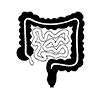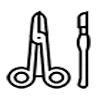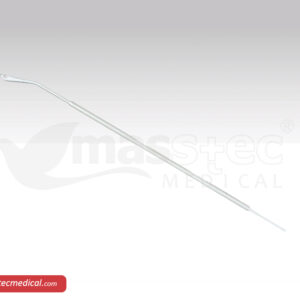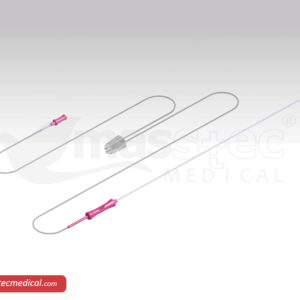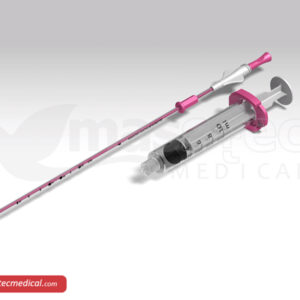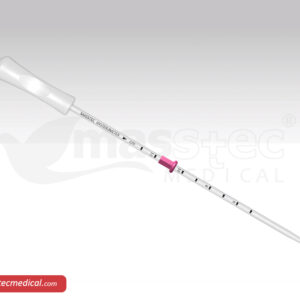Procedure
Pre-Procedure Preparation:
•A mock transfer may be performed to map out the uterine pathway.
•The patient’s bladder is often kept partially full to straighten the uterine angle, aiding smoother catheter passage.
2. Embryo Loading:
•The embryo(s) are aspirated into the catheter in a small volume of culture medium, typically less than 10 microliters, to ensure minimal handling.
3. Insertion and Placement:
•The catheter is gently inserted through the cervix and guided into the uterine cavity under ultrasound or tactile guidance.
•Embryos are released near the endometrial midline, around 1-2 cm from the uterine fundus, which is considered optimal for implantation.
4. Post-Transfer Check:
• The catheter is checked for any retained embryos to ensure complete transfer.
Embryo Transfer Catheter Set – Masstec Medical Co.
During the IVF procedure, the embryo is placed into the uterus using a special device called an Embryo Transfer Catheter.
Embryo Transfer Catheter is a vital tool used in assisted reproductive technology (ART) procedures, especially during in vitro fertilization (IVF). This device comprises two catheters, namely the guiding catheter and the transfer catheter which facilitates the safe, precise, and effective transfer of embryos into the uterus to maximize the chances of successful implantation and pregnancy.
The choice and handling of embryo transfer catheters significantly influence the outcome of IVF treatments. Modern catheter designs are the result of extensive research and clinical trials aimed at improving ease of use, reducing patient discomfort, and optimizing pregnancy success rates.
| Material and Structure: | Dual Design |
•Made from medical-grade, biocompatible materials
•Designed to prevent damage or irritation to the endometrial lining (the inner layer of the uterus). | •Our catheters have an inner catheter that holds the embryo and an outer guide sheath for smooth insertion and better control |
| Size | Visibility |
•Diameter: Guiding catheter dimensions: 17 cm × 6.6 Fr ensuring ease of passage through the cervix. •Length: Often between 17 to 23 cm, to accommodate uterine size variations. | •The guiding catheters are marked with graduations to help measure insertion depth. |
| Soft tip | Types of Embryo Transfer Catheters |
•The rounded, flexible tip minimizes trauma to the uterine lining and enhances patient comfort.
•Reduces the risk of embryo retention in the catheter. | Soft Catheters:
•Made from highly flexible materials.
•Ideal for patients with a straightforward cervical and uterine anatomy.
•Reduce the risk of uterine contractions.
Firm/Rigid Catheters:
•Provide additional control for challenging cervical pathways.
•Often used in cases of cervical stenosis or when mock transfers show difficulty in catheter passage.
Guided Catheters:
•Equipped for ultrasound-guided transfers, ensuring precise placement of the embryo in the uterine cavity. |
| Challenges | Advantages of Using High-Quality Catheters |
Cervical Difficulties:
•In cases of cervical stenosis (narrow cervix), more rigid catheters or dilators may be required.
Uterine Contractions:
•Improper insertion techniques or use of inappropriate catheters can trigger uterine contractions, reducing implantation success.
Embryo Retention:
•If embryos remain inside the catheter after withdrawal, the procedure must be repeated, potentially affecting embryo viability. | Higher Pregnancy Success Rates:
•Smooth, atraumatic designs prevent uterine contractions that could expel embryos.
•Accurate placement improves the likelihood of successful implantation.
Reduced Patient Discomfort:
•The soft, flexible design minimizes discomfort and trauma to the cervix and uterus.
Minimized Risk of Embryo Retention:
•Advanced designs ensure that embryos are fully deposited and not retained within the catheter.
Versatility:
•Available in various sizes and stiffness levels to cater to different patient anatomies and clinical challenges. |














